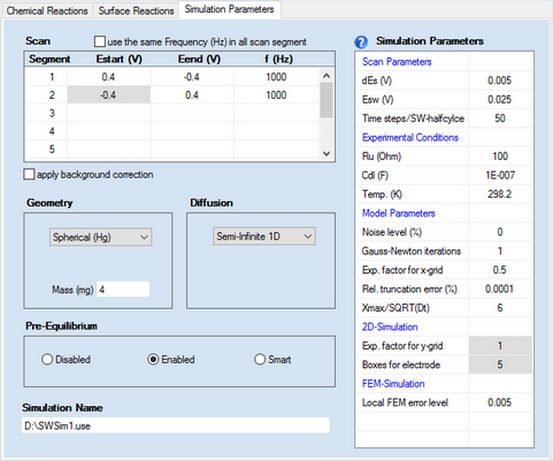1. Scan Parameters:
•Scan segment, Estart (V), Eend (V), f(Hz)
DigiElch provides a highly flexible way for defining the potential scan used in the square wave experiment. The overall scan can be composed of any number of scan segments characterized by starting potential, Estart (V), end-potential, Eend (V) and the square wave frequency, f (Hz).
Examples 1: (classical SW-experiment, 1 scan segment is executed)
segment index
|
Estart (V)
|
Eend (V)
|
f (Hz)
|
comment
|
1
|
0
|
-1
|
100
|
Potential moves from 0 to -1V with f=100 Hz
|
| Examples 2: (cyclic SW-experiment, 2 scan segments are executed) |
segment index
|
Estart (V)
|
Eend (V)
|
f (Hz)
|
comment
|
1
|
0
|
-1
|
300
|
forward scan from 0 to -1V with f=300 Hz
|
2
|
-1
|
0
|
300
|
backward scan from -1 to 0V with f=300 Hz
|
Examples 3: (3 scan segments are executed )
segment index
|
Estart (V)
|
Eend (V)
|
f (Hz)
|
comment
|
1
|
0
|
-0.5
|
300
|
forward scan from 0 to -0.5 with f=300 Hz
|
2
|
-0.5
|
-1
|
200
|
forward scan continues to -1V with f=200 Hz
|
3
|
-1
|
1
|
400
|
backward scan from -1V to +1V with f=400 Hz
|
 Estart - values plotted on a grey background are automatically filled in. They are "read only" and cannot be edited/modified. This ensures a "smooth scan" where the starting potential of a scan is always equal to the end potential of the previous scan. Estart - values plotted on a grey background are automatically filled in. They are "read only" and cannot be edited/modified. This ensures a "smooth scan" where the starting potential of a scan is always equal to the end potential of the previous scan.
•Check Box: use the same value of f(Hz) in each scan segment
If this check box is ticked any modification of f (Hz) will be taken over for all other scan segments. •Check Box: apply background correction
This check box is visible only if both Ru (Ohm) and Cd (F) are different from zero. The need for this option is similarly as demonstrated in the CV-example.
 This check box is visible only if Cdl (F) > 0 and Ru(Ohm) > 0. This check box is visible only if Cdl (F) > 0 and Ru(Ohm) > 0. •Esw (V), dEs (V)
Square wave amplitude and potential steps. The definition of the square-wave signal by Estart (V) = Ei, Esw (V) , dEs (V) and f(Hz) = τ-1 becomes clear from the following picture:
 Figure 1
•Time steps/SW-halfcylce
Indicates the number of time steps used for simulating the current referring to the end points of the t/2 - cycles.
 τ (and consequently f(Hz)) must be equal within a scan segment (characterized by starting and end potential) but may differ from scan segment to scan segment. Esw and dEs must be equal in all scan segments. τ (and consequently f(Hz)) must be equal within a scan segment (characterized by starting and end potential) but may differ from scan segment to scan segment. Esw and dEs must be equal in all scan segments.
Removing scan segments:
A scan segment (and all subsequent scan segments) can be removed by entering an empty string into the associated Eend - input filed. For instance, if a user wants that only the first scan segment is executed in Example 2, an empty string must be entered into the input field "Eend (V)" associated with the scan index 2.
Relationship to OSWV (Osteryoung Square Wave Voltammetry)
In the case of OSWV the height of the difference peak current for a reversible charge-transfer can be expressed by the following equation

where ψp has been tabulated in a paper by Osteryoung and O’Dea (J. Electroanal. Chem. 14, 209 (1986)) as function of the OSWV parameters ΔEs and ΔEp, respectively. The relation between these parameters and those used by DigiElch is as follows:
ΔEs = dEs
ΔEp = ½ Esw
tp = 1/(2*f)
|







